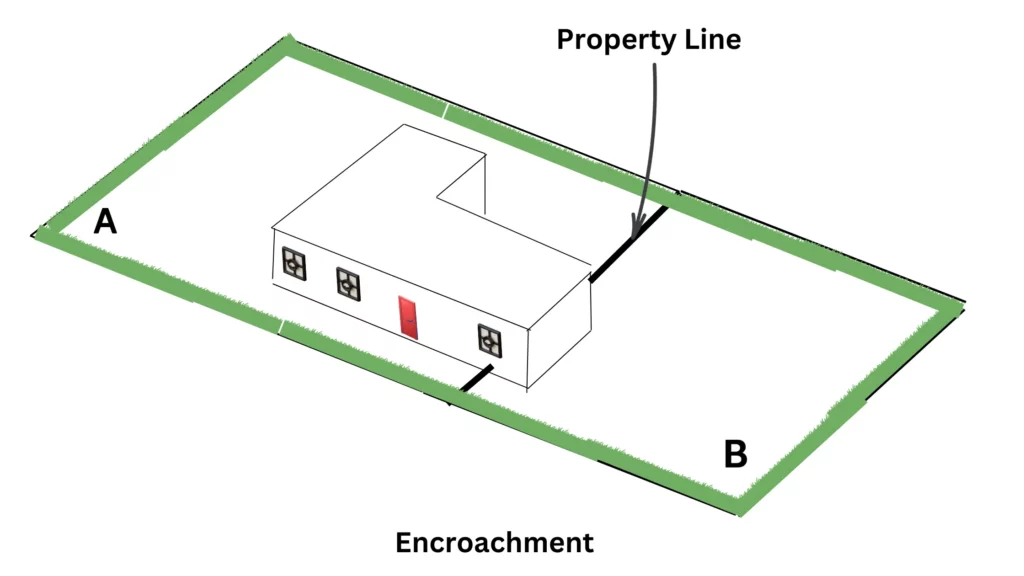
Yearly, homeowners lose ~$108,000 in terms of revenue and $190,000 in additional losses due to encroachment. Encroachment in real estate is when someone builds or extends onto a neighbor’s property without consent.
Encroachment can occur intentionally, such as when a neighbor builds on land they don’t own, or unintentionally when property lines are unclear. Despite seeming minor, it can lead to legal issues, property damage, and sales complications.
👉 Quick Gist
- A surprisingly common encroachment issue involves tree branches or roots that extend over a property line.
- Encroachment can lead to disputes over maintenance responsibility, potential damage to property, and even shade or sunlight concerns.
- In rare instances, someone might intentionally encroach on a neighbor’s property, eventually acquiring the legal ownership through a concept called adverse possession.
What Is the Definition of Encroachment?
Encroachment means when someone, intentionally or accidentally, crosses onto their neighbor’s land by constructing or expanding a structure.
This happens in property line disputes or when people don’t know where their land ends. Encroachments take various forms, such as construction, a fence, or any structure that crosses the property line.
These forms are primarily categorized into two types of encroachments:
- Minor Encroachments: Minor encroachments are small, usually unintentional, e.g. like a fence or tree crossing property lines. But they still need a resolution.
- Major Encroachments: Major encroachments include significant violations like building part of a house on a neighbor’s land. This leads to serious disputes and can end with legal actions.
Generally, encroachments are a controversial issue, as they violate the rights and boundaries of property owners.
What Are the Problems of Encroachment?
Problems due to property encroachments can trigger a range of issues with significant consequences such as:
- Altercation: Encroachments escalate and result in strained relationships and emotional anxiety for all parties involved.
- Affect Property Values: A buyer may be doubtful to invest in a property with encroachment issues. It may lead to decreased demand and lower sale prices.
- Costly Legal Battles: Resolving encroachment in court can be costly, including legal fees, court expenses, and possible compensation payouts.
- Time-Consuming Process: Legal proceedings related to encroachments can be lengthy, causing significant delays in property transactions or development projects.
- Property Use Restrictions: Encroachment restricts property use and makes some areas unusable.
- ✍️ Fact: Vermont’s wetlands lost 35% (121,000 acres) through encroachment and conversion prior to the 1980s. Such encroachment increases the chances of a local flood causing property damage and loss of human life.
Reasons Property Owners Encroach
Know the common reasons why property owners encroach on neighboring lands:
- Boundary Confusion: Encroachment can occur when a property owner isn’t clear about the exact location of the property’s boundary. This confusion may be due to inaccurate surveys or unclear property descriptions.
- Disregarding Property Lines: Property owners may ignore property lines out of negligence or that small encroachments won’t cause problems.
- Mistaken Assumptions: In a few cases, property owners may assume they have certain rights over a part of a neighboring property. This assumption might be due to verbal agreements, historical usage, or a misreading of property laws.
- Lack of Awareness: Property owners may unknowingly extend trees or home improvements beyond their boundaries when making additions or alterations without proper surveying.
- Financial Gain: In rare instances, property owners might intentionally encroach on neighboring land to gain financial benefits. These include expanding their usable space or access to resources in the encroached area.
- Neighborhood Norms: If multiple property owners are encroaching on the neighbors’ land without objection, new property owners might follow suit as an unintentional neighborhood norm.
In summary, property owners encroach due to misconceptions, assumptions, or, rarely, for financial gain. To handle encroachment issues effectively these reasons are vital.
How to Deal With Encroaching?
When faced with encroachment issues, it’s crucial to understand your options. Here are steps to address encroachment effectively.
- Know Your Grounds: You need to obtain surveys and review land records. These documents provide important information about property lines and help pinpoint any encroachment.
- Talk to the Encroacher: To find an effective solution, start a friendly talk with the encroacher as they may not be aware of the problem.
- Strike a Deal: Fix the situation by a compromise or formalize the encroachment land through legal means, such as an easement agreement.
- File a Claim: If informal discussions fail, document the encroachment evidence and file a formal petition with the town selectman.
- Get Legal Counsel: Seek the advice of a qualified attorney. A counsel is a wise step especially if negotiations stall or the matter is complex.
- File a Lawsuit: Finally, to address the encroachment you need to take the matter to court and seek a judgment that favors you.
However, going to court can’t make problems easier. The judge might rule that your neighbor’s use of your property is acceptable similar to a prescriptive easement. Or, if it’s against the law, they may instruct your neighbor to knock it down.
Encroachment vs. Easement
Encroachment and easement are common real estate terms for property use and access rights. Easement is an agreed-upon use while encroachment means unauthorized use.
Encroachment involves unauthorized construction on someone else’s land. Easements are the legal right to use another person’s land for purposes like access to a neighbor’s driveway or to install utility lines.
Special Considerations
You need to focus on legal details and available alternatives to handle encroachments. Consider the following:
- Local Laws Vary: Laws about encroachments differ by location. These laws are influenced by local ordinances, state regulations, and neighborhood-specific rules.
- Legal Advice is Essential: It’s crucial to consult with an attorney with experience who can offer tailored guidance within your area’s legal framework to avoid encroachment.
- Consider Alternatives: A legal advisor can help you look at mediation or other forms of dispute resolution that can be explored against costly court battles.
- Take Preventive Measures: Property owners can obtain boundary surveys and document property lines to reduce the risk of property encroachment issues in the first place.
Ending Reflections
In conclusion, to prevent encroachment escalation you need to know your property boundaries supported by official land records. While a polite discussion is often the first step, never underestimate the importance of addressing encroachments.
Ignoring them can complicate home sales, as what’s tolerable to you may not suit the next owner. So, to safeguard your property rights and ensure a smooth real estate journey vigilance and proactive resolutions are key.
Find Your New Home With Houzeo
With thousands of property listings, Houzeo.com is one of the biggest property listing sites in the US. Find condos, townhouses, co-ops, and other types of homes for sale on Houzeo.














.webp)
